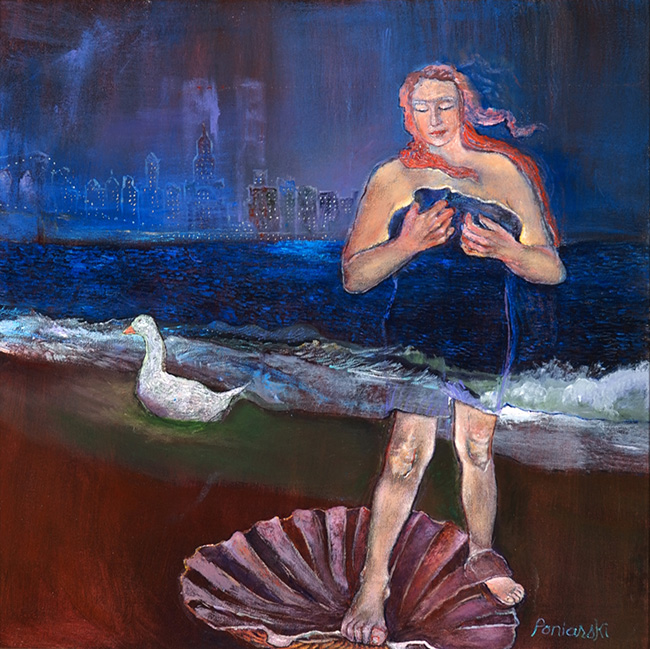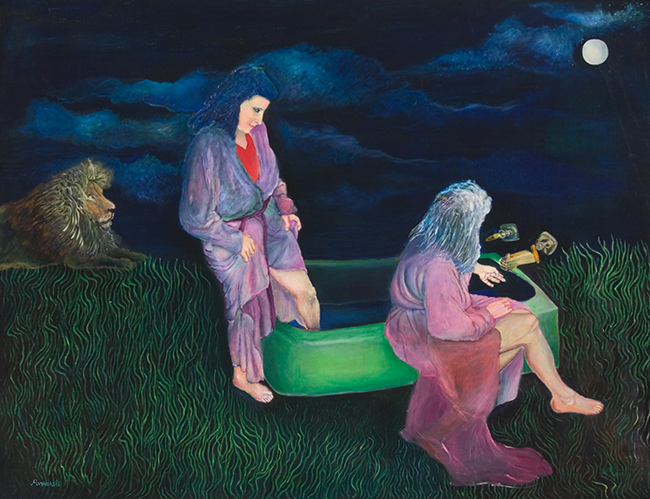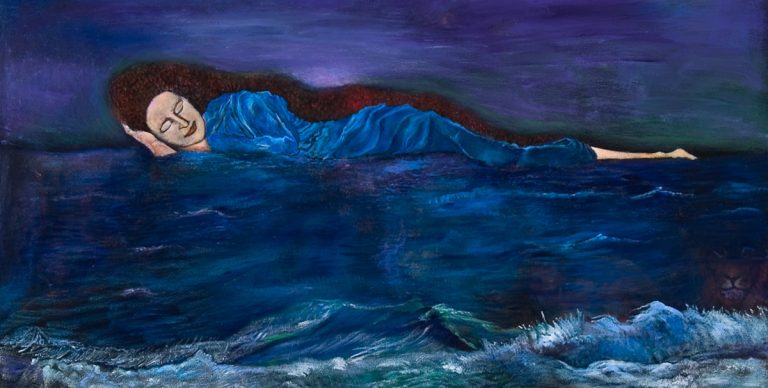Ruth Poniarski didn’t begin her life as a painter. Her creative path started with structure—literally. She earned a Bachelor of Architecture from Pratt Institute in 1982 and spent ten years in the construction field. But architecture, for all its logic and form, wasn’t enough. In 1988, she pivoted. Painting offered something else entirely: a way to explore the unknown. It didn’t follow a blueprint. It asked questions. It gave her room to bring together myths, culture, philosophy, and literature into a surreal, expressive language of her own. That decision—leaving behind hard angles for the freedom of canvas—opened the door to decades of imaginative work. Her paintings are curious and thoughtful, rich with symbolism, and unapologetically personal.
Let’s take a closer look at three of her pieces: The Second Wave, The Birth of Venus, and Bather’s Invention. Each offers a different window into how she sees the world—and how she reinterprets it.

The Second Wave shows a world on the edge of something new. A wave rises, not just as a literal sea swell, but as a symbol of transformation. A creature watches—perhaps us, perhaps something else—as a past imprint is pulled back into the ocean. There’s a sense of mourning in this loss, but also a quiet faith in what’s coming. The second wave isn’t violent; it’s necessary. It fills the space left behind. That rhythm between loss and replenishment plays out not just in the painting’s watery landscape, but in how it’s constructed: soft transitions of color and form, brushwork that mimics the pull and release of tides. Poniarski isn’t just capturing nature—she’s using nature to speak about memory and the cycle of becoming.

In The Birth of Venus, Poniarski engages with a well-known myth but moves it away from the traditional Renaissance imagery. Her Venus emerges not in an idealized pose, but as part of a more layered, internal world. The shell arrives on a wave, yes, but here it feels like a vessel of thought more than body. There’s a sense that something is being processed—a moment of breath, of hesitation—before crossing into something new. The ocean isn’t just water; it’s time. And Venus, born of foam in older versions of the myth, becomes here a more grounded figure. She’s caught between the natural and the metaphysical. The painting speaks of seasons and solitude, of growth cracking through silence. It’s about beauty, but not the polished kind—it’s beauty as awakening, as disruption.

Bather’s Invention brings us somewhere else entirely. A hollowed-out tree. Mushrooms. A waterfall in the wild. It sounds like a dream, and in some ways it is—but the dream has structure. A lion finds the space and becomes its protector. Eve appears, interacting with the water as if trying to decode its ritual. There’s a practical side to this myth, too: she’s adjusting droplets, readying herself, preparing to cleanse. The moonlight overhead isn’t just atmospheric—it’s functional, giving her the visibility she needs. Poniarski mixes wild nature with symbolic gestures. The tree isn’t just a tree. The bath isn’t just for hygiene. Everything in the painting hints at rebirth, at the body’s relationship to the earth and the cosmos. There’s a push and pull between primal instinct and thoughtful care.
Across all three works, Poniarski uses imagery not to explain but to suggest. Her style isn’t about clean interpretation. It’s layered. She weaves in visual riddles. A tree may also be a womb. A wave might be memory. A shell, a threshold. She leans on myths because they hold up under scrutiny and still leave room to dream. They let her speak to big themes—change, love, isolation, rebirth—without locking them down.
Her paintings don’t demand an answer. Instead, they offer a space to pause. To reflect. To look again. Ruth Poniarski’s shift from architecture to painting wasn’t just about changing materials—it was about loosening the grip of design to let intuition in. Her work holds that tension between form and feeling, between what we know and what we sense. And it’s in that space—in the second wave, in the quiet before Venus steps forward, in the moonlit bath—that her art speaks most clearly.

